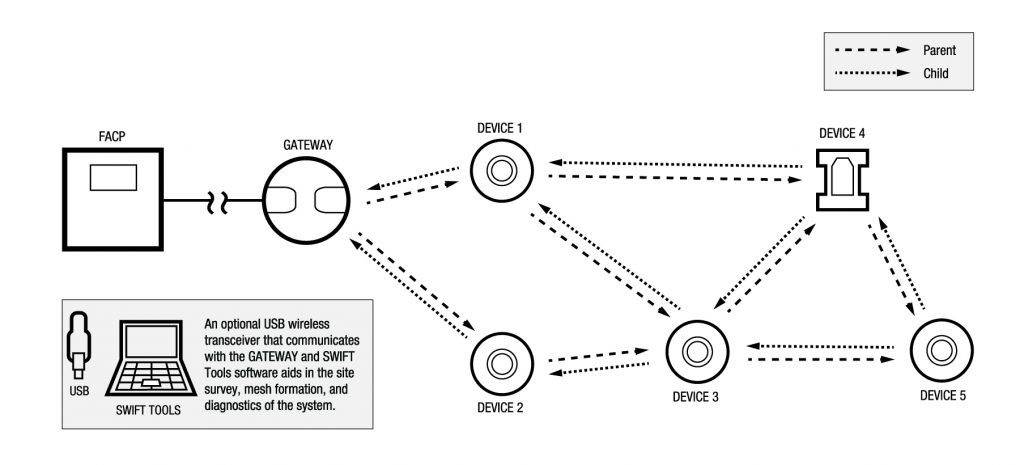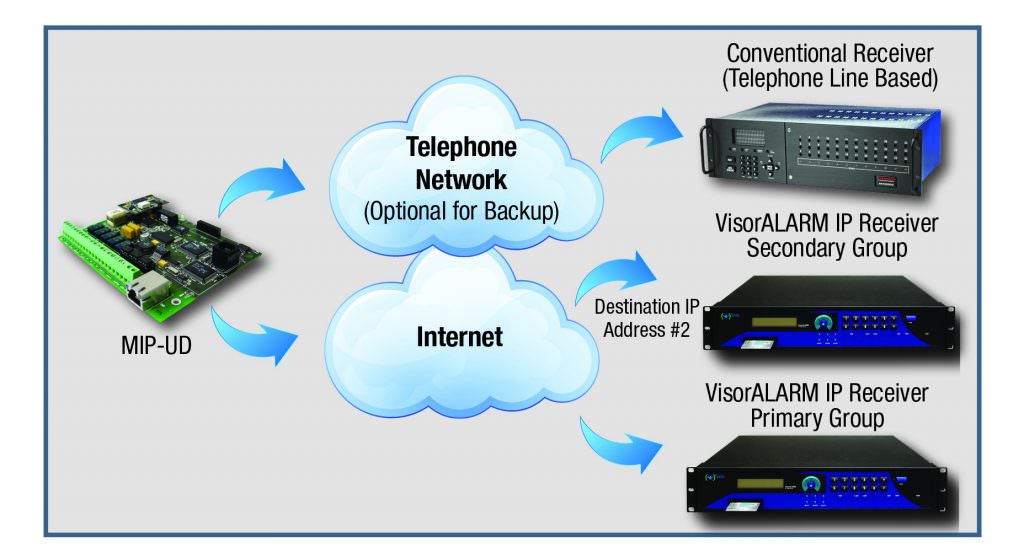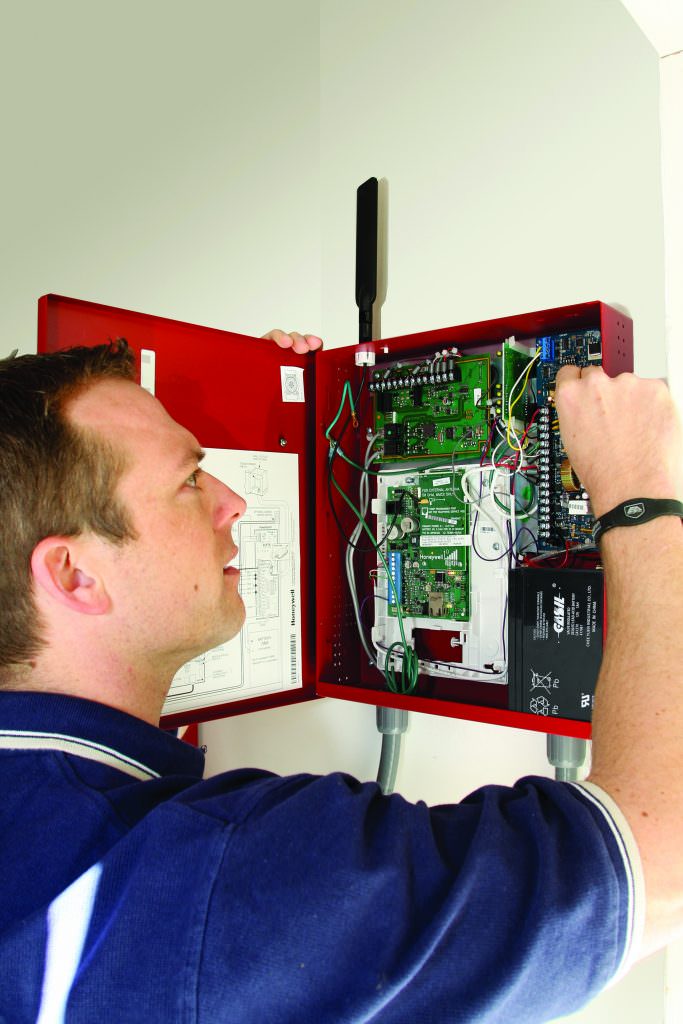Removing the Barriers: The Wireless Side of Fire Protection and Life Safety

The industry’s wireless movement is fueling innovation

Richard Conner, Fire-Lite Alarms and Silent Knight
This is an exciting and challenging time in the fire alarm and life safety industry. Historically, the sector has seen subtle changes through technological advances, combined with more drastic changes resulting from unfortunate local and global events. Even more profound are the effects that recent innovations in wireless technology have had on fire alarms, from detection to central station communication.
As installers look at new ways to expand fire alarm coverage in areas of limited infrastructure, detection devices that leverage wireless networks have emerged as a valuable new offering.
Fire alarm system manufacturers have heavily invested in research to determine what networks work best for life safety applications, where communication methods must be highly reliable.
On the side of central station communications, the telecommunications industry is changing rapidly, as well. Plain old telephone service (POTS) lines are being phased out to support wireless and IP-based alternatives that enable increased communication speed and improved accessibility to data. As a result of this transition, cellular carriers and device makers have changed their focus, offering new technologies and powerful cellular networks to handle consumer demand for increased bandwidth. As the focus on IP and cellular networks grows, the fire alarm market has had to adopt alternative communication methods to ensure network and device communications are reliable and up-to-code.
How can these developments save customers money while ensuring investment protection from future technology changes? How can customers get the best return on investment when migrating to a fully wireless cellular solution? Let’s take a closer look at the changing landscape for fire alarm systems and examine how wireless and alternative communications can help installers enhance system reliability and ensure a high level of customer support.
A Wireless World
Wireless devices deliver a new level of reliability and flexibility to the fire alarm market. A variety of networks, including mesh, point-to-point and point-to-multipoint, can be used to transmit information and data wirelessly. These different solutions provide different benefits and value propositions. Let’s take a look at each.
Wireless mesh networks allow installers to connect many devices via a network that “blankets” the area, rather than requiring that each device have a direct wireless or wired connection to the termination point. In a Class A mesh network, each smoke detector and monitor module, for example, creates its own communication structure. That means that communication travels from point A to point B through any number of these devices, creating multiple, redundant communication paths. With multiple paths to employ, the system’s reliability is maximized. If one device is lost, the remaining devices will immediately find another path for communication. This is known as a self-healing network.

Point-to-point (P2P) technology provides a dedicated link between two devices. For example, P2P enables communication between two smoke detectors, or between a monitor module and the main controlling element of a fire alarm network. P2P technology is reliable, but it also tends to be more expensive and more time-intensive to install. Plus, if one device fails, it could affect the entire network.
Point-to-multipoint (P2MP) technology is a hybrid between mesh and P2P wireless networking. With this type of network, central units connect to multiple “subscriber” units. In order to function, all P2MP networks require that all subscriber units be in range of the central unit. If they are not, additional central repeater units are required. For many installations, this makes P2MP networks impractical and prohibitively expensive. In addition, the failure of a central unit or repeater could mean failure for multiple subscriber units.
Devices used for fire protection and life safety require a mesh network with bi-directional communication to ensure reliable data transmission.
Therefore, we’ve determined that devices used for fire protection and life safety require a mesh network with bi-directional communication to ensure reliable data transmission. In fact, we’ve even developed terminology for this approach, calling it a “parent-child” relationship: every child device has at least two parents to send information through, and every child device may also be a parent to other child devices. That way, inbound and outbound communications can use various paths through the parent and child devices, ensuring that every message is received, which is obviously vital to the operation of life safety systems.
Mesh Networks and Fire Alarms
Mesh networks deliver many new benefits to the fire alarm market. Devices that use this communication method provide incredibly reliable fire alarm communication. Frequency hopping prevents system interference, and the network’s infrastructure creates redundant communication paths between each device, so if one device is lost, the others immediately find another path for communication. This is critical in the fire alarm market, where immediate and robust device communication can mean the difference between fire prevention and fire response.
A mesh network also provides installers with the flexibility to extend a fire alarm system quickly and easily. In addition, it benefits the end user by keeping costs low, while providing self-healing capabilities and the highest level of reliability and protection.
New wireless fire detection solutions are particularly well suited for difficult or obtrusive applications where running wire is challenging. Based on a Class A mesh network, these solutions deliver the same reliability that is expected from a commercial “wired” fire alarm system. Typical applications for such wireless technologies are parking garages, historic buildings and warehouses. Whether for new installations or retrofits, the fire alarm system can be a combination of wired and the new wireless devices, allowing for easy expansion and additional flexibility.
Central Station Reporting
Fire alarm systems that offer multiple options for central station communications are critical for today’s installations. The growth in new communication networks has pushed central stations to look at the ways in which they can support alternative communication methods and the new fire alarm communicators supporting those networks.
POTS has been used in the fire alarm industry for more than 40 years and has mainly been viewed as reliable. But communication providers now view the network as archaic and obsolete. In fact, the Federal Communications Commission (FCC) reports that POTS is not sustainable, and the agency is “seeking ways to phase out relics of a bygone industry.” Unfortunately, because many fire alarm systems were designed specifically to report to central stations over this legacy network, devices will need to be updated as the use and support of POTS declines.
For alternative communication options, a variety of cellular formats are available, and all have different effects on cellular monitoring. Compared to POTS, second-generation (2G), third-generation (3G) and fourth-generation (4G) cellular networks offer significantly better speed and coverage. While improved speed is not a requirement in the fire alarm market because the amount of data being transferred is not significant, reliability and longevity are key. A fire alarm control panel needs to be connected and communicating at all times in order to transmit life safety events, and, for the safety and economic benefits of end users, needs to last for many years.
Many jurisdictions today allow alternate means of communication; however, they often vary in acceptance of dual-path (two technologies) or single-path (one technology). As an example, dual-path could be IP and GSM (cellular) and single-path could be just one of those technologies. Once you know what is accepted, it is a matter of preference and available communication infrastructure at the protected premises. Additionally, regardless of the chosen technique, technologies that are field-configurable to allow customization to a specific application should be evaluated.

Standards for Alternative Communication
Central stations must comply with new communication standards based on NFPA 72-2013. The new standards describe approved communication methods for central station reporting, as well as options for alternative communication methods not specifically outlined in the published standards. Specified supervision requirements for single-path (cellular only and IP only) and multiple-path (IP primary with cellular for backup, or IP primary with POTS lines for backup) technologies are also published in this edition. What are the most significant changes in the 2013 standards?
Generally speaking, the NFPA standards change the supervision requirements for single and multiple-path technologies. For single-path communication technology, the central station must annunciate a fault condition within 60 minutes after loss of communication. When using multiple-path communication technologies, the central station must annunciate trouble within six hours after loss of communication.
Chapter 26 of the NFPA 72-2013 standards outlines requirements for communications, and communicators that transmit alarms must comply with its mandates for central station reporting. Furthermore, this section states that it does not limit the use of alternative communication networks, such as cellular or IP, for central station reporting.
Transmission channel requirements specifically look at the decline of POTS and how central station communications need to be set up to prepare for the sunset. For example, section 26.6.3.2.1.4 of the NFPA code states that, with one exception, a second communication technology must be used when employing a telephone line. The transmission means outlined in the code include a one-way private radio alarm system, a two-way RF multiplex system, or a transmission means complying with section 26.6.3.1. Approval can be given by authorities to use two phone lines in areas of reduced cellular or IP network infrastructure, but if two phone lines are used, each line needs to be tested at alternating six-hour intervals.
These changes in standards are all designed to simplify service and monitoring, while ensuring comprehensive safety parameters. Overall, they help reduce unnecessary service calls and enable new technologies in more jurisdictions.

Central stations are free to expand support for new digital technologies to further prepare for changes in network development, and to provide support for new and innovative fire alarm devices. At the same time, delivering support for legacy POTS technology is critical to helping fire alarm installers and customers.
Today, a more modern central station infrastructure helps installers save on installation and maintenance costs, allows users to reduce ongoing service requirements, and enables authorities to achieve stronger reliability for transmitting fire alarm signals.
Cellular Communication Standards
When selecting a cellular communicator, it is important to understand which cellular network is being used and to make sure that the specific coverage required for the communicator is available in the location needed.
It cannot be stressed enough: Do your research. Make sure there are no immediate plans to discontinue the network on which the fire alarm communicator operates.
For example, support for 2G service, launched in the United States in 1987, is diminishing at a rapid rate. In fact, AT&T announced that it expects to completely discontinue their 2G cellular networks by 2017. 3G networks appear to have somewhat more longevity because of the significant research and development that was done to ensure network robustness and a longer lifespan, but rumor has it that major carriers will look to discontinue support in 2020. 4G – designed and launched in 2010 to support the growing demand for data transmission – currently offers the fastest speeds available, and coverage continues to be expanded as companies invest in this technology. There are different 4G formats, such as LTE and HSPA+ that vary by carrier.
Realizing the value of 4G and its long-term viability, manufacturers have designed new cellular communicators to leverage the benefits of 4G technology to ensure the best coverage and the most longevity possible. For example, the top fire communicators produced today connect to the DACT of any UL-listed fire alarm control panel and communicate over 4G cellular, IP/Ethernet or both. This approach allows customers to save on the costs of expensive POTS lines, while offering comprehensive and reliable network coverage.
At the same time, new communicators enable increased flexibility by allowing the conversion of fire alarm control panels from POTS to cellular or IP, with single or dual-path technology for central station communication and the ability to work on 2G, 3G and 4G networks.
Market Evolution
The fire alarm industry has experienced dramatic change over the past few years. As support for POTS further declines, new technologies, including the wireless devices and fire alarm communicators discussed above, are having a significant impact on the market. These new technologies are expanding opportunities for installers and central stations and ensuring a higher-than-ever level of protection for customers.
Richard Conner (richard.s.conner@honeywell.com) is director of marketing for Fire-Lite Alarms (www.firelite.com) and Silent Knight (www.silentknight.com).
